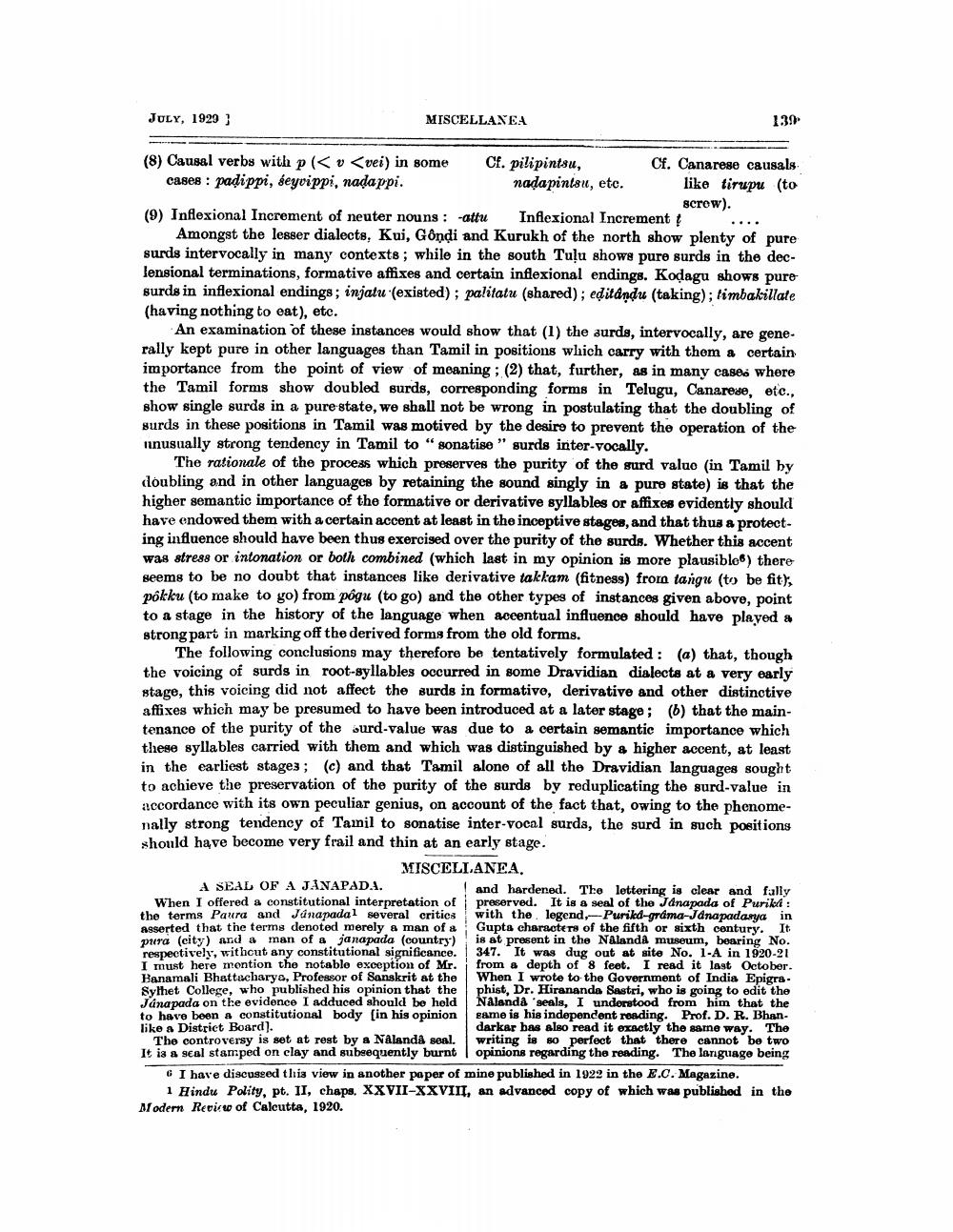________________
JULY, 1929
MISCELLANEA
139
(8) Causal verbs with p ( v <vei) in some Cf. pilipintsu, Cf. Canarese causals cases : padippi, seyvippi, nada ppi.
nadapintsu, etc. like tirupu (to
screw). (9) Inflexional Increment of neuter nouns: -attu Inflexional Increment !
Amongst the lesser dialects, Kui, Gôndi and Kurukh of the north show plenty of pure surds intervocally in many contexts; while in the south Tuļu shows pure surds in the declensional terminations, formative affixes and certain inflexional endings. Kodagu shows pure surds in inflexional endings; injatu (existed); palitatu (shared); editandu (taking); timbakillate (having nothing to eat), etc.
An examination of these instances would show that (1) the aurds, intervocally, are gene. rally kept pure in other languages than Tamil in positions which carry with them & certain importance from the point of view of meaning ; (2) that, further, as in many cases where the Tamil forms show doubled surds, corresponding forms in Telugu, Canarese, etc., show single surds in a pure state, we shall not be wrong in postulating that the doubling of gurds in these positions in Tamil was motived by the desire to prevent the operation of the unusually strong tendency in Tamil to “sonatise " surds inter-vocally.
The rationale of the process which preserves the purity of the surd value in Tamil by doubling and in other languages by retaining the sound singly in a pure state) is that the higher semantic importance of the formative or derivative syllables or affixes evidently should have endowed them with a certain accent at least in the inceptive stages, and that thus & protecting influence should have been thus exercised over the purity of the surds. Whether this accent was stress or intonation or both combined (which last in my opinion is more plausible) there seems to be no doubt that instances like derivative takkam (fitness) froro tangu (to be fit), pôkku (to make to yo) from pôgu (to go) and the other types of instances given above, point to a stage in the history of the language when accentual influence should have played # strong part in marking off the derived forms from the old forms.
The following conclusions may therefore be tentatively formulated : (a) that, though the voicing of surds in root-syllables occurred in some Dravidian dialects at a very early stage, this voicing did not affect the surds in formative, derivative and other distinctive affixes which may be presumed to have been introduced at a later stage; (b) that the maintenance of the purity of the surd-value was due to a certain semantic importance which these syllables carried with them and which was distinguished by a higher accent, at least in the earliest stage3; (c) and that Tamil alone of all the Dravidian languages sought to achieve the preservation of the purity of the surds by reduplicating the surd-value in accordance with its own peculiar genius, on account of the fact that, owing to the phenomenally strong tendency of Tamil to sonatise inter-vocal surds, the surd in such positions should have become very frail and thin at an early stage.
MISCELLANEA. A SEAL OF A JÄNAPAD.A.
and hardened. The lettering is clear and fally When I offered a constitutional interpretation of preserved. It is a seal of the Janapada of Purika : the terms Paura and Janapadal several critics with the legendPurikd-grama-Janapadarya in asserted that the terms denoted merely a man of & Gupta characters of the fifth or sixth century. It pura (city) and a man of a janapada (country) is at present in the Nalanda museum, bearing No. respectively, without any constitutional significance. ! 347. It was dug out at site No. 1-A in 1920-21
otablo exception of Mr. i from & depth of 8 feet. I read it last October Banamali Bhattacharya, Professor of Sanskrit at the When I wrote to the Government of India Epigra. Sylhet College, who published his opinion that the phist, Dr. Hirananda Sastri, who is going to edit the Janapada on the evidence I adduced should be held Nalanda 'seals, I understood from him that the to have been constitutional body [in his opinion game is his independent reading. Prof. D. R. Bhanlike a District Board).
darkar bas also read it exactly the same way. The The controversy is set at rest by a NAlanda seal. writing is so perfect that there cannot be two It is a seal stamped on clay and subsequently burnt opinions regarding the reading. The language being
G I have discussed this view in another paper of mine published in 1922 in the E.C. Magazine.
1 Hindu Polity, Pt. II, chaps. XXVII-XXVIII, an advanced copy of which was published in the Modern Recirs of Calcutta, 1920.




